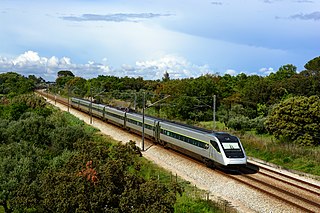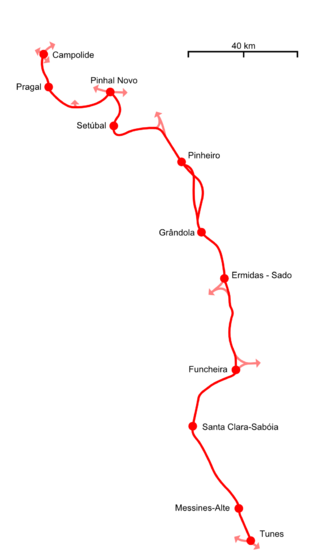
Seixal is a Portuguese city and municipality, located in the district of Setúbal, in the metropolitan area of Lisbon. Its population includes 184,269 inhabitants (2011), in an area of 93.58 square kilometres (36.13 sq mi) that includes six parishes. It is situated across the Tagus River estuary from Lisbon. Its seat is the city of Seixal, a centre of 31,600 inhabitants situated along the Rio Judeu.

Almada is a city and a municipality in Portugal, located on the southern margin of the Tagus River, on the opposite side of the river from Lisbon. The two cities are connected by the 25 de Abril Bridge. The population of the municipality in 2011 was 174,030, in an area of 70.21 km2. The urbanized core center, the city of Almada proper, had a population of 101,500 in 2001. It makes part of the Lisbon Metropolitan Area.

The 25 de Abril Bridge is a suspension bridge connecting the city of Lisbon, capital of Portugal, to the municipality of Almada on the left (south) bank of the Tagus River. It has a main span length of 1,013 metres (3,323 ft), making it the 48th longest suspension bridge in the world.

REFER, Rede Ferroviária Nacional, EP was the Portuguese rail infrastructure manager. It was a state-owned company and was created to manage the Portuguese rail infrastructure, previously under control of CP, which became exclusively a train service operator.

CP — Comboios de Portugal, EPE is a state-owned company which operates passenger trains in Portugal. Prior to June 2009, CP stood for Caminhos de Ferro Portugueses although the company has been using its current designation as a brand name since 2004.

The Alfa Pendular network, with top speeds of 220 km/h connects much of Portugal. In February 2009, the government of Portugal announced plans to build a high-speed rail line from Lisbon to Madrid; this plan was cancelled in March 2012 amidst a bailout programme of financial assistance to the Portuguese Republic. The project was valued at €7.8 billion and the government had claimed it would create 100,000 jobs. The line would link to Spain's Southwest Corridor.

Several companies provide rail transport in Portugal.

The Santa Apolónia Station is the oldest railway terminus in Portugal. It is situated in the civil parish of São Vicente, in the central part of the municipality of Lisbon, on the northern margin of the Tagus River in the historical district of Alfama.

The Metro Transportes Sul do Tejo is a light rail system that provides the Almada and Seixal municipalities, Portugal with mass-transit services.

The history of rail transport in Portugal dates from 28 October 1856, when Portugal's first railway line was opened between Lisbon and Carregado: the Companhia dos Caminhos de Ferro Portugueses.

The Douro line is a 99-mile railway line in northern Portugal that runs from Ermesinde to the eastern terminus at Pocinho. The line runs close to the Douro River for much of its route, offering scenic views of the river and valley. Passenger trains are operated by Comboios de Portugal (CP) and run between Porto São Bento and Pocinho, taking 3 hours and 20 minutes. Freight trains operated by Medway also run on the line.

Areeiro is a station on the Green Line of the Lisbon Metro serving the Areeiro neighbourhood. The station is located in the Praça Francisco Sá Carneiro, just south of the Roma-Areeiro railway station.

Oriente is a station on the Red Line of the Lisbon Metro. The station is located in Lisbon, between the Cabo Ruivo and Moscavide stations. The station is a part of the Gare do Oriente, one of the main transport hubs of the city, serving the North, Sintra, and Azambuja Lines and also several bus lines.

Jardim Zoológico station is part of the Blue Line of the Lisbon Metro.

Entre Campos station is part of the Yellow Line of the Lisbon Metro.

Linha do Algarve is a railway line in the region of Algarve, in southern Portugal, which connects the stations of Lagos to the west and Vila Real de Santo António to the east of the Portuguese region.

Linha do Sul is a Portuguese railway line which connects Campolide A, in Lisbon, and Tunes, in the Algarve. The first section, from Pinhal Novo to Setúbal, was opened in 1861. The route to Funcheira opened on 25 May 1920. In 2003 it was linked to Lisbon, crossing the Tagus River on the 25 de Abril Bridge.

Sete Rios Station is a railway station located in the city of Lisbon. It is served by the Sintra and Azambuja Lines, as well as the private operator Fertagus. It is managed by Infraestruturas de Portugal.

Campolide Station is a railway station located in the city of Lisbon. It is served by the Sintra and Azambuja Lines, as well as the private operator Fertagus. It is operated by Lisbon CP and managed by Infraestruturas de Portugal.

























